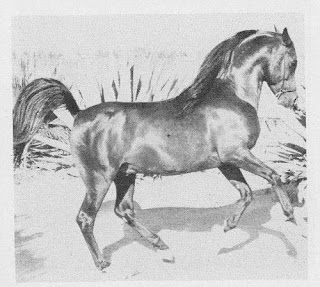Char Echo (Negem x Sirhabba)
"Mr. Reid, you can't buy the quality you are looking for. You have to buy one of these and produce what you are wanting." - Homer Watson to Floyd Reid, August 1968
This story starts over forty years ago. Floyd Reid had traveled to Rancho San Ignacio, to look at the mares Raya del Sol (*Rashad Ibn Nazeer x *Bint Moniet el Nefous) and Faaraa (Faarad x *Binte el Bataa). He wanted to purchase either mare from Richard Pritzlaff and with high hopes, he and his wife set out for New Mexico, in search of their Egyptian dream. The mares were everything that Floyd imagined them to be and more, however, it was not meant to be. With the Pritzlaff mares as a new standard, the Reids set out for a comparable Egyptian mare, this time at the Babson Farm. They saw many beautiful mares, unfortunately, all of the mares that he liked were not for sale. In December of the same year, Floyd Reid visited Dr. Keith Krausnick of Shar-Char Farms in Lamar, Colorado. Dr. Krausnick suggested the chestnut mare, Sirhabba (Sirecho x Habba), bred by Mrs. John Ekern Ott. Floyd's wife, Margaret, who has an artist's eye, was impressed by this "pretty mare" and after they had gone home, encouraged Floyd to consider her. While Floyd told me that Margaret was not a horse person, in the strictest sense of the word, he believes that artistically, Margaret felt that overall, Sirhabba's quality and old world type was reminiscent of the horses she remembered seeing at Pritzlaff's ranch.
By the time that Floyd Reid had met Sirhabba, she was a proven broodmare, as she had already produced 5 colts and 2 fillies, for Shar-Char Farms:
- 1963: Sirgem (by Negem)
- 1964: Char Echo (by Negem)
- 1965: Char Rabdan (by Negem)
- 1966: Shar Gema (by Negem)
- 1967: Shar Gemla (by Negem)
- 1968: Char Sirab (by Fa-Serrab)
In February of 1969, Floyd Reid purchased Sirhabba, in foal to Fa-Serrab (Fabah x Serr Abba). Three months later, Sirhabba produced the mare FaSerrabba. Floyd had admired the stallion, *Ansata Ibn Halima, since visiting Ansata in May of 1965. The visit to Ansata was so powerful in Floyd Reid's life, it altered the course of his breeding program. Soon after seeing *Ansata Ibn Halima, Floyd dispersed his champion Arabian horses, including his National Top Ten stallion, Rahym, in favor of establishing a straight Egyptian breeding program. I asked Floyd why he wanted to breed to *Ansata Ibn Halima,
"We had attended and shown at the Arabian National Championships, eight years in Colorado and four years in Oklahoma by the time we bought Sirhabba. I had never seen a "better" horse."
It is significant that in his search for just the right Egyptian mare to breed to this stallion, Floyd chose Sirhabba. I asked Floyd why he felt Sirhabba would be a good match for *Ansata Ibn Halima and he replied,
"When we returned with the trailer and I 'first' looked at Sirhabba, I was satisfied, she was a pretty, little mare. She was in foal to a nice stallion, Fa-Serrab, and I saw no glaring faults that I thought would fail to blend with *Ansata Ibn Halima."
I also asked Floyd about his expectations or rather, his goals, in using horses like Sirhabba and *Ansata Ibn Halima. He told me,
"All that I wanted was to get a couple of pretty, grey mares out of *Ansata Ibn Halima x Sirhabba."
And so, Floyd Reid bred Sirhabba to *Ansata Ibn Halima not once but twice, producing the mare Sirhalima and the stallion, Al Karim Sirhalima (aka AK Sirhalima). While Floyd retained the mare FaSerrabba, he eventually sold a pregnant Sirhabba, together with her *Ansata Ibn Halima daughter, Sirhalima, to Bentwood Farms.
He took the mare, FaSerrabba to Ansata el Sherif, to produce the mare Fa Sherifaa, who eventually became an important mare in Marilyn Lang's program.
Sirhabba, now at Bentwood Farm, was exclusively bred to *Ibn Moniet el Nefous, to produce 2 colts and 2 fillies:
- 1973: AK Sirmoniet (colt)
- 1975: AK Monahabba (filly)
- 1976: AK Nasaar (colt)
- 1977: AK Bint Sirhabba (filly)
Little did Floyd Reid understand at the time he purchased Sirhabba, how he was to become the catalyst for this particular line of horses, insuring that the beloved mare, Habba, while lost in matrilineal descent within straight Babson Egyptian lines, would survive and prosper within straight Egyptian breeding.
***You can read the story of Sirhabba in its entirety within The Arabian Breeders' Magazine, Volume II, Issue IV.***

No comments:
Post a Comment